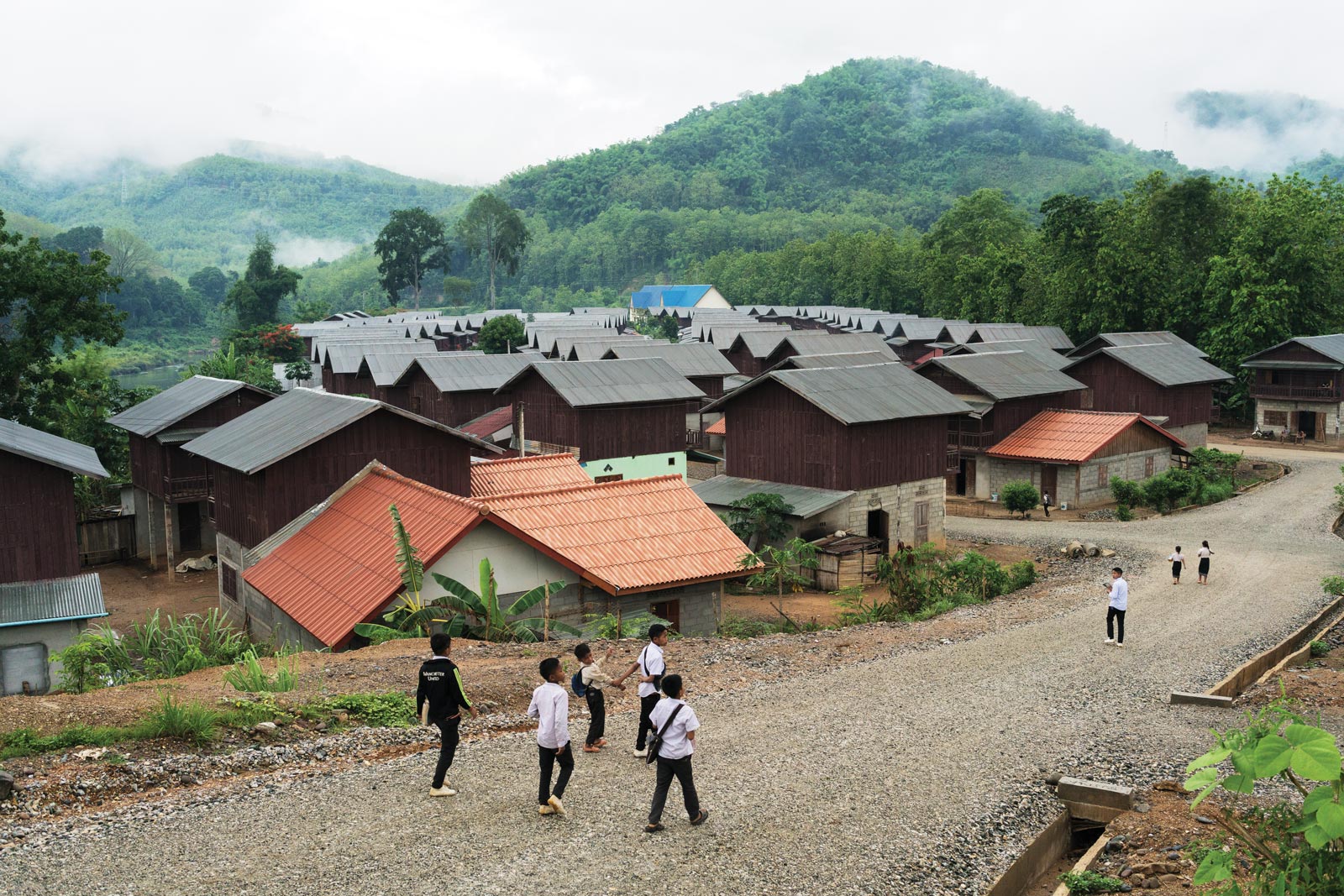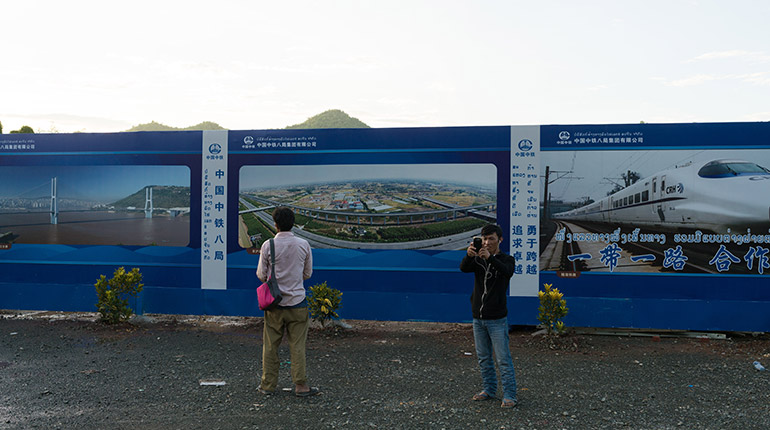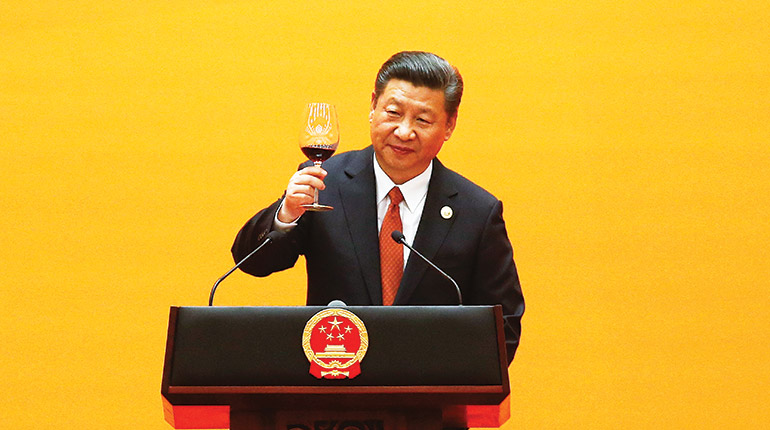In the deep valleys of northern Laos, the Nam Khan River – a major tributary of the mighty Mekong – slices through extraordinary scenery. Towering, mist-covered mountain ranges; a sublimely preserved Unesco heritage-listed city that was once a royal capital; rippling rice paddies and fishing villages are just some of the dreamy scenes along its banks. Since 2015, though, it has also flowed through two massive, Chinese-built hydropower dams, the last of which was completed one year ago.
The dams were designed by Power China and built by the state-owned, Chinese energy construction firm Sinohydro – the biggest hydropower dam company in the world. The estimated $314m it cost to build the pair of dams was covered by soft loans to the tiny, landlocked country by the Export–Import Bank of China at an interest rate of 2% per year.
They’re just two of the projects that are part of the Lao government’s goal to export massive amounts of power to Thailand and Vietnam through a proposed 72 dams and become the ‘battery of Southeast Asia’. One of the more recent dams, the Nam Khan 3 Hydropower Project, opened its towering floodgates just over a year ago, transforming a nine-square-kilometre valley that was once home to thousands of farmers and fishermen into a wide and still reservoir. Most have taken resettlement packages and relocated to the Samaky Sai camp, a dusty village of new concrete cube homes. While the area has modern amenities such as plumbing and electricity, what it lacks are the resources the villagers were accustomed to surviving on – tillable soil; firewood; fish.
It’s this sort of give and take that makes Chinese President Xi Jinping’s signature foreign policy vision, the One Belt, One Road endeavour (also known as BRI), “probably the most important issue facing the region”, according to one economist. Governments from Laos to Lithuania are being given access to massive amounts of capital for new projects and infrastructure overhauls as Xi presses ahead with plans to build a ‘new Silk Road’, but it’s on China’s terms.
As one of the poorest members of Asean, Laos is becoming increasingly dependent on Chinese aid, investment and construction. Over the past few years, Beijing has helped the developing nation build not just hydropower projects, but also major highways, mines and monolithic hotels to fuel a growing tourism industry. In the past six months, troops of Chinese construction workers have drilled and hammered away at the bones of another example of Chinese-funded infrastructure: a single-track, high-speed, electrified, mixed-traffic railway line that will soon stretch 420km from the Yunnan border to the Lao capital, Vientiane. It’s part of a sprawling project that will one day connect freight and passengers through eight Asian countries. With cost estimates at $6 billion – again through soft loans provided by Beijing – the railway is 70% owned by China Railway and 30% by the Laos government and is set to be completed by 2021.

These two infrastructure developments join hundreds of other Chinese projects around the globe that involve the superpower underwriting billions of dollars of infrastructure investment in countries along the original Silk Road, linking up China with Western Europe through a web of railways, roads and ports that run through the Middle East, Asia, Africa and Eastern Europe. The BRI will not only provide markets for China’s industrial overcapacity, it will facilitate trade, strengthen regional and global diplomatic ties, find a more profitable home for China’s massive foreign-exchange reserves and ensure it has energy efficiency.
We need to be getting proposals to China. All the talk is there, but the implementation is still lacking
Chheang Vannarith, Chairman of the Cambodian Institute for Strategic Studies
This extraordinary, almost unprecedented, economic and geopolitical development by a single nation will span more than 60 countries and see Chinese goods and technology stream into Europe through new maritime routes and a Chinese-owned port in Greece. New, high-speed train lines will fan out across the globe, linking up Jakarta and Bandung, Hungary and Serbia, and Malaysia and Singapore; tunnels will be built in Israel; a $54 billion highway will link China to a deep water port in Pakistan. Just like the ancient Silk Road quested by Zhang Qian in 130BC, the routes are multiple and interweaving; there is no one belt or road, but rather a complex network.
Unsurprisingly, BRI has been met enthusiastically in Southeast Asia, a region that for the most part is in dire need of development to remain economically competitive, but short on domestic funding to make it happen. BRI promises countries such as Laos, Cambodia and Myanmar not just infrastructure but also trade, technology, tourism and an industry lift, while for China, it provides a platform to develop deeper ties with Asean and a market for its technology and services.
“It’s a multidimensional story,” said Hal Hill, a professor of Southeast Asian economies at Australian National University.
“We have got a highly controversial and abrasive president in the US and, by comparison, China’s sending out all the right messages to the rest of the world that, as the alternative global superpower, they are interested in development, not attacking people, so the soft power story is really important,” he said, adding that it was a win-win situation: China’s surplus, while declining, was still huge at about $3 trillion, and that needed to be recycled, while infrastructure was something that every nation needs more of.
The vehicle for BRI projects will mainly be the Asian Infrastructure Investment Bank (AIIB) which, although in principle a multi-lateral institution, is steered by China, which has also established a $40 billion Silk Road Fund. Other Chinese policy banks are expected to invest up to $1.3 trillion in BRI over the next few decades; in 2015, China transferred $82 billion to three state-owned banks for BRI projects.
But when it comes to emerging economies such as Laos, the multimillion-dollar question is who will pay for infrastructure such as the train. “It’s almost certainly going to be soft loans and not grants. And that means debt,” Hill said. But if Laos’ $6 billion train doesn’t turn out to be commercially viable, who picks up the tab for it? “It all comes down to careful, rigorous cost-benefit scrutiny and evaluation – hard in any country but especially in China and Laos, which are not the most transparent of places,” he said.
“Every interaction of this kind tends to have a mix of motives – altruism, humanitarianism, naked self-interest and strategic tactical interest. Would you trust America? Should East Timor trust Australia? What is clear is that One Belt, One Road is probably the most important issue facing the region, especially the poor contiguous states of Indochina, right now,” he said.
The Asian Development Bank (ADB) has historically been one of the largest infrastructure providers in Asia. Jayant Menon, the lead economist at the ADB’s office for trade and regional cooperation, acknowledged that the region possessed an infrastructure deficit that “even 10 ADB’s couldn’t fill”. Yet he stressed that countries that were already heavily indebted – such as Laos and Cambodia – needed to be selective over where investment was going.
“There is a real risk of non-essential projects being financed for the wrong reasons. China has its own strategic perspectives,” he said. One of these, he believes, is the new high-speed train line in Laos, which he said would not have a good return in terms of welfare improvement to the poor. “From experience we have learned that these fast train projects will only work when there is high density and high disposable incomes. Laos has neither. I think it’s very risky for the Lao economy.”
Rather, Menon said infrastructure such as ports and airports should be the priority, such as the new $880m international airport proposed for Siem Reap. The Cambodian government awarded the construction contract to Chinese state-run Yunnan Investment Holdings. “Tourism is an important growth industry, so improving facilities will help,” said Menon.
“But what we have learned at the ADB is that physical infrastructure is only half the story,” he added. “Policy needs to work to ensure the infrastructure is used to its maximum – especially when it comes to border crossing transit and transport agreements. So a lot of the existing infrastructure is not even fully utilised right now.”
Another consideration developing countries should keep in mind, added Hill, were fluctuating exchange rates: if the debt were in Chinese renminbi and it appreciated, debt would rapidly increase. Further, because countries such as Cambodia and Laos tend to have weak bureaucracies, they don’t have well-developed analytical think tanks and have typically been aid dependent. “They have a mentality of waiting for foreign assistance. When the official development assistance (ODA) is in grant form, they don’t need to analyse so much. They need to change that mindset,” said Hill. A level of unease has lingered amongst some Asean governments and organisations over dependence on China and political motivations that could lead to ‘debt bondage’.

Another issue is whether friction in the South China Sea could have a negative impact on China’s vision. At an International Institute for Strategic Studies security summit in June, Malaysian defence minister Seri Hishammuddin Hussein said “the dream for countries in our region for better infrastructure and stronger economies” would be futile if hostilities continued. “I think China has realised that without stabilising the South China Sea they can’t realise the maritime Silk Road,” said Chheang Vannarith, chairman of the Cambodian Institute for Strategic Studies. “Things will cool right down in the region regarding the South China Sea – Xi Jinping’s legacy hangs on it, and he only has five more years to build it.”
There is a real risk of non-essential projects being financed for the wrong reasons. China has its own strategic perspectives
Still, the general perception from Southeast Asian politicians appears to be that the benefits outweigh the risks. According to ADB statistics, the region will need $26 billion in investment by 2030 to meet regional infrastructure demands. At a tourism meeting in Siem Reap last month, Cambodian Prime Minister Hun Sen remarked that he expected the “excellent” BRI policy to lead to a significant spike in tourism in the Kingdom.
China has been Cambodia’s biggest external lender since 2010, investing in hydropower dams, roads, bridges, satellite cities, industrial factories and ports that are closely linked to the BRI. In Cambodia’s north, a joint venture between China Huaneng Group and the local Royal Group is developing the $900m Lower Sesan 2 hydropower dam, while China Communications Construction has already pumped more than $1.6 billion into 16 highway projects in the country, including a 190km expressway linking the capital with Sihanoukville on the coast, expected to break ground this year.
According to Vannarith, most important was that the Cambodian government linked the BRI with its own national development strategies and goals. “But Hun Sen still doesn’t have a clear action plan. Cambodia needs $600m in infrastructure development and logistics networks to maintain our current rate of economic growth. China has sought our consultation on this, rather than just coming in with its own policy and asking us to implement it, as the World Bank and US do. We need to be getting proposals to China. All the talk is there, but the implementation is still lacking,” he said.
Also worth noting, Vannarith said, were projects where social and environmental impact studies had not been completed. “We need to manage infrastructure in a sustainable way. Areng Valley [a dam project postponed and then halted due to widespread community opposition] is an example of a project that didn’t work because there was a lack of consultation and environmental impact assessment. Investment is about benefiting the local people, we need to engage them and inform them on what ways infrastructure benefits them,” he said.
In fast-rising Myanmar, whose GDP growth was at 7.7% this year, news emerged in May that China was willing to abandon a suspended, controversial $3.6 billion dam project in Myitsone due to protests and civil unrest. Meanwhile, Chinese plans to sponsor a $20 billion road and railway linking the deep-water port at Kyaukphyu with Kunming in Yunnan have hit a snag due to opposition in Myanmar over security issues and community consultation. For the most part, however, China has found little trouble in getting big projects off the ground in developing Southeast Asian countries.

Meanwhile, Asean nations with more robust ‘first world’ infrastructure such as Singapore, Malaysia and even Thailand have another incentive to embrace Xi’s vision: to remain in China’s orbit. “China has been the most important locomotive for the region and the world so it’s critical they stay connected,” said Hill. But with the BRI bringing regional connectivity on an unprecedented scale, could Singapore’s most important asset – its position as the premier trade and financial centre between the Indian Ocean and South China Sea – be weakened?
“I think Singapore only stands to gain from BRI,” said Menon. David Wijeratne, PwC’s growth markets centre leader in Singapore, agreed, saying the city-state’s free trade, low tax regimes, absence of foreign exchange controls, diversified talent pool and sound legal systems positioned it as an ideal facilitator of investments into less business friendly, developing BRI nations. “These platforms in Singapore will be critical meeting points for companies with similar commercial interests along the value chains,” he said. The city-state has assets under management of $1.8 trillion, and last year it was the top destination for foreign direct investment linked to the ‘new Silk Road’.
Back in in Laos, construction continues to rocket along on the $6 billion train. Huge factories have sprouted around cities such as Luang Prabang, in which local and Chinese workers manufacture railway parts along assembly lines. Hill pointed out that China’s development model has historically been quick and efficient but did not tend to lead to much local knowledge transfer. “They come in with the whole package and just get things done,” he said. Indeed, in the four years it took to build the Nam Khan 3 Hydropower Project, about 300 Chinese workers poured into the remote valley.
Some locals got jobs on the project, and Southeast Asia Globe met one such person on the muddy banks of the reservoir last month. This middle-aged former farmer, who declined to give his name, now earns about $200 a month as a truck driver for the dam, and has used the income he’s generated to build a boat and floating restaurant on the reservoir geared towards local weekend tourists. Other villagers, he said, have been employed as maintenance staff, while engineers tended to come from Vientiane.
“For the past few years, we’ve heard as much Chinese [language] here as we have Lao,” he said. “For me, the dam has made a positive impact on my life. It’s easier to access schools and hospitals. I do miss the old way of life. At the site that we were relocated to, the river is a trickle and there are no fish. It is not black and white. I have a more comfortable life now, but many poorer people are struggling. If you don’t have a job, it’s hard to eat – you cannot grow food now, you have to buy it. But this is development.”


